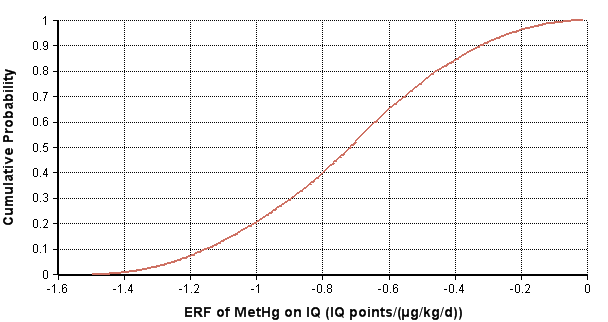ERF of methyl mercury on intelligence quotient: Difference between revisions
(updated for format and the newest model) |
m (→Formula) |
||
| Line 53: | Line 53: | ||
=== Formula === | === Formula === | ||
;Conversion 1 (Analytica): <Anacode>triangular(-1.5,-0.7,0)*Blood_to_hair</Anacode> | |||
;Conversion 2: triangular(-1.5,-0.7,0)*(0.8007*BW*250*0.001) | |||
== Result == | == Result == | ||
Revision as of 20:01, 16 September 2009
| Moderator:Olli (see all) |
|
|
| Upload data
|
Scope
What is the exposure-response function (ERF) of methyl mercury on intelligence quotient between exposure to prenatal methyl mercury and intelligence quotient (IQ) score in children?
Definition
Data
Study by Cohen et al[1] finds that prenatal MeHg exposure sufficient to increase the concentration of mercury in maternal hair at parturition by 1 µg/g decreases IQ by 0.7 points. The paper identifies important sources of uncertainty influencing this estimate, concluding that the plausible range of values for this loss is 0 to 1.5 IQ points.
A triangular distribution with parameters: min = 0, mode = 0.7 and max = 1.5 was created. Distribution by author judgement [2]. D↷
Conversion 1:
This variable includes conversion from mercury intake to mercury concentration in hair. Firstly, WHO(1990) suggests the use of a single-compartment model, through which the steady-state Hg concentration in blood (C) in µg/l is related to the average daily dietary intake (d) in µg of Hg, as follows: C = 0.95 * d. Secondly, blood mercury was converted to total hair mercury using a 1:250 ratio (New Zealand and Seychilles Island studies) and an assumption of equivalent maternal and cord levels.[3] D↷
Conversion 2:
Another conversion from MeHg hair concentration into dietary MeHg intake is proposed by EPA [4]. This conversion is used in the Bayesian Belief Network (BBN) model developed for the fish case study in Beneris project. Assuming that the concentration of MeHg in blood is at a steady-state the daily dietary intake of MeHg from fish corresponding to a given hair MeHg concentration can be estimated as
Intake_MeHg_Fish(ug/kg bw-day) = (a*1000*Concentration_MeHg_Hair(ug/g hair)*b(1/day)*V(L blood))/ (250(L blood/kg hair)*A*f*BW(kg bw))
were:
- Concentration_MeHg_Hair is the hair MeHg concentration,
- b is the elimination rate from blood (assumed 0.014[4]),
- V is the blood volume (assumed 5 L[4]),
- f is the fraction of absorbed MeHg that is distributed to the blood (assumed 0.059[4]),
- A is the fraction of ingested MeHg that is absorbed from GI tract (assumed 0.95[4]),
- BW is the body weight of pregnant woman,
- a is the proportion of daily dietary intake of MeHg by pregnant women that comes from fish (assumed 1=100%),
- 250 is the hair-to-blood Hg concentration ratio.
As a result, the ERF of MeHg exposure from fish for the child's IQ can be calculated as a product of ERF of MeHg hair concentration for child's IQ and (A*f*BW*250*0.001)/(b*V).
Dependencies
List of parent variables:
Unit
- Conversion 1
- IQ points / 1 µg/g increase in maternal hair
- Conversion 2
- IQ points/(µg/(kg bw*day))
Formula
- Conversion 1 (Analytica)
- <Anacode>triangular(-1.5,-0.7,0)*Blood_to_hair</Anacode>
- Conversion 2
- triangular(-1.5,-0.7,0)*(0.8007*BW*250*0.001)
Result
NOTE! Conversion 2 was used for the current results.
{{#opasnet_base_link:Op_en1806}}
References
- ↑ Methyl mercury: Cohen et al 2005a
- ↑ User:Jouni 9 Feb 2008
- ↑ Methyl mercury: Bidone et al. (2004)
- ↑ 4.0 4.1 4.2 4.3 4.4 EPA (IRIS), 2001. http://www.epa.gov/iris/subst/0073.htm
